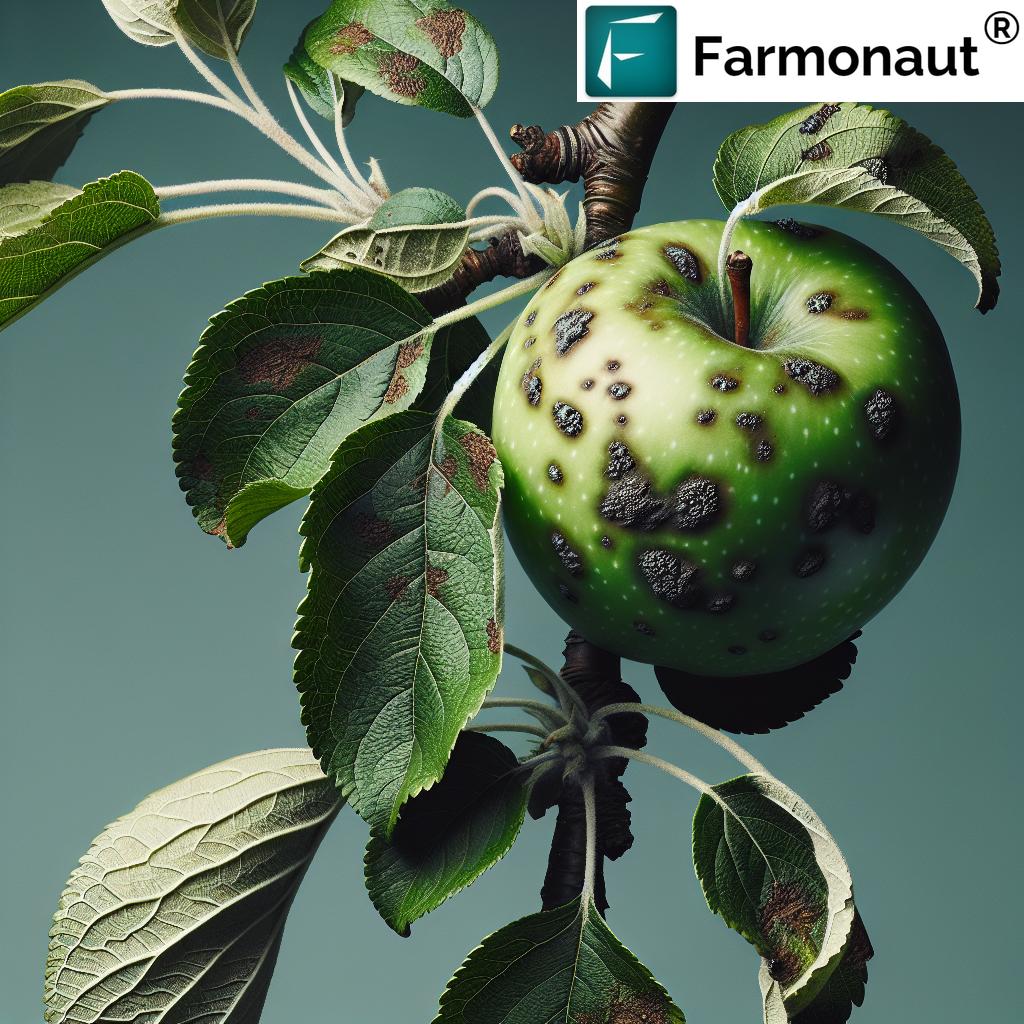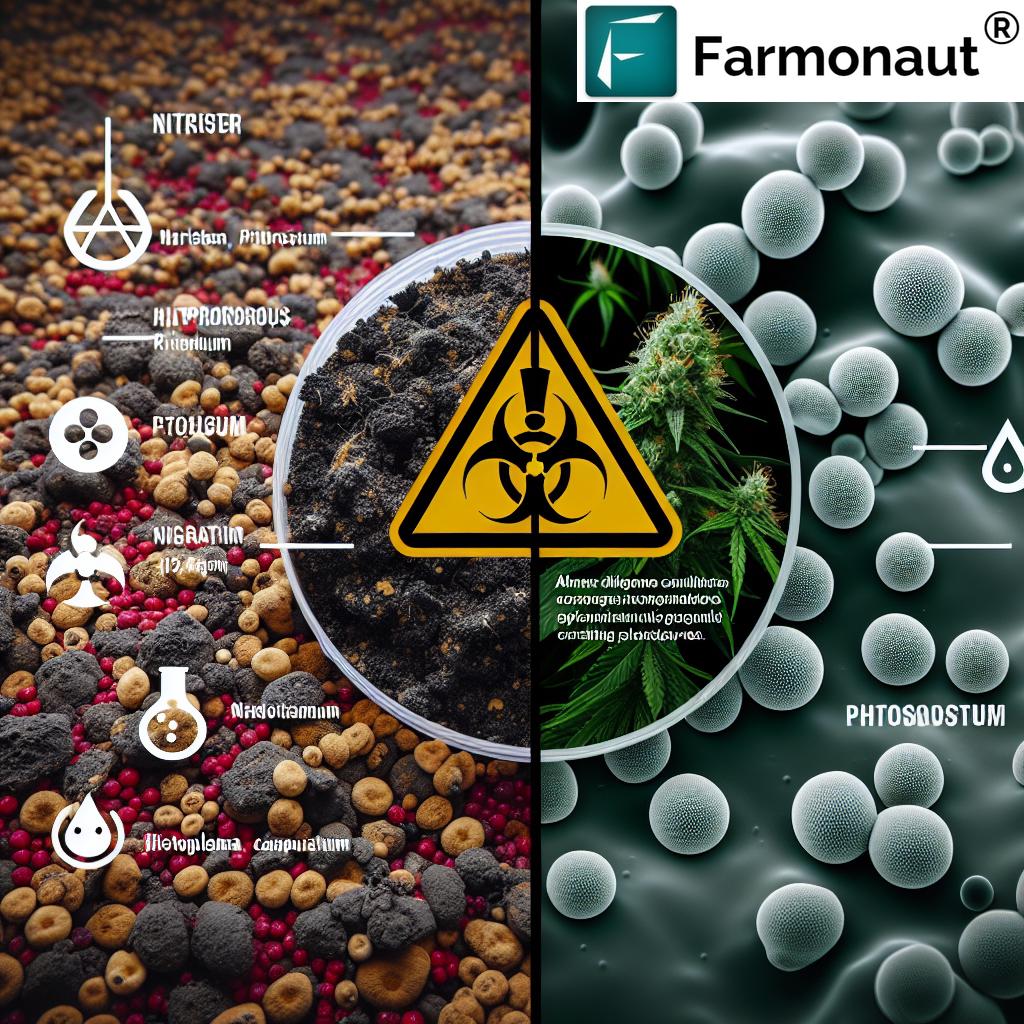
Verticillium Wilt: A Comprehensive Guide to Symptoms, Treatment, and Control for 20+ Affected Plants
At Farmonaut, we understand the challenges that farmers face when dealing with plant diseases. One particularly troublesome fungal infection that affects a wide range of crops is Verticillium wilt. In this comprehensive guide, we’ll explore the intricacies of this disease, its symptoms, and effective treatment methods for over 20 commonly affected plants. We’ll also discuss how our advanced satellite-based crop monitoring system can help in early detection and management of Verticillium wilt.
Understanding Verticillium Wilt
Verticillium wilt is a soil-borne fungal disease caused by two species of fungi: Verticillium dahliae and Verticillium albo-atrum. These pathogens can survive in the soil for many years, making them particularly challenging to eradicate. The disease affects a wide range of plants, including many economically important crops.
How Verticillium Wilt Spreads
The fungi responsible for Verticillium wilt can spread through various means:
- Contaminated soil
- Infected plant debris
- Contaminated farm equipment
- Wind-blown soil particles
- Irrigation water
Once the fungus enters the plant through the roots, it colonizes the vascular system, blocking water and nutrient transport. This leads to the characteristic wilting symptoms that give the disease its name.
Symptoms of Verticillium Wilt
Recognizing the symptoms of Verticillium wilt is crucial for early detection and management. While symptoms can vary depending on the host plant, some common signs include:
- Wilting: Leaves may wilt during the day but recover at night in the early stages.
- Yellowing: Leaves often turn yellow, starting from the lower part of the plant.
- Leaf scorch: Leaf edges may turn brown and dry out.
- Stunted growth: Affected plants may be smaller than healthy ones.
- Vascular discoloration: Cutting through the stem may reveal brown streaks in the vascular tissue.
It’s important to note that these symptoms can be similar to other plant diseases or environmental stresses. This is where Farmonaut’s advanced satellite-based monitoring system can be invaluable, helping to distinguish Verticillium wilt from other issues through early detection of stress patterns in crops.
Plants Commonly Affected by Verticillium Wilt
Verticillium wilt can affect a wide range of plants, including many important agricultural crops. Here’s a list of some commonly affected plants:
- Tomato: One of the most susceptible crops, with severe yield losses reported.
- Potato: Can cause significant damage to potato crops worldwide.
- Pepper: Both sweet and hot pepper varieties are susceptible.
- Eggplant: Highly susceptible, with potential for complete crop loss.
- Cucumber: Can affect both field and greenhouse-grown cucumbers.
- Melon: Various melon types, including cantaloupe and honeydew, can be affected.
- Pumpkin: Susceptible to infection, particularly in warmer climates.
- Watermelon: Can cause significant yield reductions in watermelon crops.
- Broccoli: While generally less susceptible, some varieties can be affected.
- Cabbage: Can cause stunting and reduced head size in cabbage crops.
- Cauliflower: May lead to uneven curd development and reduced yields.
- Celery: Can cause significant losses in celery production.
- Garlic: May affect bulb development and overall plant health.
- Kohlrabi: Can lead to reduced bulb size and quality.
- Lettuce: Affects various lettuce types, potentially causing complete crop failure.
- Onion: Can lead to reduced bulb size and storage quality.
- Peas: Both garden and field peas can be affected.
- Radish: May cause stunted growth and reduced root development.
- Spinach: Can lead to wilting and yellowing of leaves, reducing marketable yield.
Given the wide range of affected crops, it’s crucial for farmers to implement proper management strategies to prevent and control Verticillium wilt. At Farmonaut, our satellite-based monitoring system can help detect early signs of stress in these crops, allowing for timely intervention.

Farmonaut’s Early Detection Capabilities for Verticillium Wilt
Our advanced satellite-based crop monitoring system at Farmonaut offers significant advantages in the early detection of Verticillium wilt symptoms across various crops. The following table compares the detection times of our system with traditional visual inspection methods:
| Crop | Visual Symptoms | Farmonaut Detection Time | Traditional Detection Time |
|---|---|---|---|
| Tomato | Wilting, yellowing leaves | 3-5 days after infection | 7-10 days after infection |
| Potato | Chlorosis, necrosis | 4-6 days after infection | 8-12 days after infection |
| Eggplant | Stunted growth, leaf discoloration | 2-4 days after infection | 6-9 days after infection |
| Cucumber | Wilting, yellowing | 3-5 days after infection | 7-10 days after infection |
| Lettuce | Stunted growth, wilting | 2-4 days after infection | 5-8 days after infection |
As demonstrated in the table, Farmonaut’s technology can identify Verticillium wilt symptoms significantly earlier than traditional visual inspection methods. This early detection capability enables farmers to implement timely interventions, potentially reducing crop losses and improving overall yield.
Treatment and Control Methods for Verticillium Wilt
Managing Verticillium wilt requires an integrated approach combining preventive measures and control strategies. At Farmonaut, we recommend a combination of cultural, biological, and chemical methods to effectively manage this disease.
Cultural Control Methods
- Crop rotation: Implement a 3-4 year rotation with non-host crops to reduce fungal populations in the soil.
- Resistant varieties: Use plant varieties that are resistant or tolerant to Verticillium wilt whenever possible.
- Sanitation: Clean and disinfect farm equipment to prevent spreading the disease between fields.
- Proper irrigation: Avoid overwatering, as excessive soil moisture can promote fungal growth.
- Soil solarization: In suitable climates, cover the soil with clear plastic during hot months to reduce fungal populations.
Biological Control Methods
Several biological control agents have shown promise in managing Verticillium wilt:
- Trichoderma species: These beneficial fungi can colonize plant roots and provide protection against Verticillium.
- Bacillus species: Certain bacteria can induce systemic resistance in plants, helping them fight off Verticillium infection.
- Mycorrhizal fungi: These symbiotic fungi can improve plant health and increase resistance to soil-borne pathogens.
Chemical Control Methods
While chemical control options for Verticillium wilt are limited, some fungicides can be effective when used as part of an integrated management strategy:
- Soil fumigants: These can be used to reduce fungal populations in the soil before planting, but they are expensive and can have negative environmental impacts.
- Systemic fungicides: Some fungicides can be applied as soil drenches or through drip irrigation to provide protection against Verticillium.
It’s important to note that chemical control methods should be used judiciously and in compliance with local regulations. Always consult with a professional or refer to the product label before applying any chemical treatments.
Organic Control Methods
For organic farmers or those looking to reduce chemical inputs, several organic control methods can be effective against Verticillium wilt:
- Compost and organic amendments: Adding high-quality compost to the soil can improve soil health and suppress soil-borne pathogens.
- Biofumigation: Growing and incorporating brassica crops (e.g., mustard) into the soil can release natural compounds that suppress Verticillium.
- Beneficial nematodes: Certain species of nematodes can prey on fungal pathogens in the soil.
- Plant extracts: Some plant-based products, such as neem oil or garlic extracts, may have fungicidal properties.
Farmonaut’s Role in Verticillium Wilt Management
At Farmonaut, we’re committed to helping farmers effectively manage Verticillium wilt and other crop diseases through our advanced satellite-based monitoring system. Our technology offers several key benefits:
- Early detection: Our system can identify stress patterns in crops before visible symptoms appear, allowing for earlier intervention.
- Precision management: By providing detailed, field-level data, we enable targeted treatment applications, reducing unnecessary chemical use.
- Monitoring effectiveness: Our continuous monitoring allows farmers to track the effectiveness of their management strategies over time.
- Historical data analysis: By analyzing past crop performance, we can help identify fields at higher risk of Verticillium wilt, enabling proactive management.
To learn more about how Farmonaut can help you manage Verticillium wilt and other crop health issues, visit our application page or explore our API documentation.
Case-Specific Management Strategies
While the general principles of Verticillium wilt management apply to most crops, some plants require specific approaches. Here, we’ll discuss management strategies for some of the most commonly affected crops:
Tomato
Tomatoes are highly susceptible to Verticillium wilt. Key management strategies include:
- Using resistant varieties, such as those with the Ve gene
- Implementing long crop rotations (4-5 years) with non-host crops
- Proper irrigation management to avoid water stress
- Soil solarization in warmer climates
Potato
For potato crops, consider the following approaches:
- Planting certified disease-free seed potatoes
- Using resistant or tolerant varieties
- Implementing a 3-4 year rotation with non-host crops
- Avoiding excessive nitrogen fertilization, which can increase susceptibility
Eggplant
Eggplants are highly susceptible to Verticillium wilt. Management strategies include:
- Grafting susceptible varieties onto resistant rootstocks
- Implementing strict sanitation practices
- Using organic soil amendments to improve soil health
- Applying biological control agents such as Trichoderma species
Cucumber and Melon
For cucurbits like cucumber and melon, consider:
- Using resistant varieties when available
- Implementing proper irrigation management to avoid water stress
- Applying organic mulches to reduce soil splashing
- Monitoring and managing nematode populations, which can increase Verticillium susceptibility
Lettuce
Lettuce crops can be severely affected by Verticillium wilt. Key management strategies include:
- Using resistant varieties
- Implementing long crop rotations (3-4 years) with non-host crops
- Proper field preparation and drainage to avoid waterlogging
- Applying biological control agents as seed treatments or soil drenches
Monitoring and Early Intervention with Farmonaut
Regardless of the specific crop, early detection and intervention are crucial for effective Verticillium wilt management. This is where Farmonaut’s satellite-based monitoring system truly shines. Our technology allows farmers to:
- Detect stress patterns in crops before visible symptoms appear
- Identify potential disease hotspots within fields
- Track the progression of the disease over time
- Assess the effectiveness of management strategies
By integrating Farmonaut’s advanced monitoring capabilities with the crop-specific management strategies outlined above, farmers can significantly improve their ability to control Verticillium wilt and minimize crop losses.
To start using Farmonaut’s powerful crop monitoring tools, download our app for Android or iOS devices.
Future Perspectives in Verticillium Wilt Management
As agricultural technology continues to advance, new methods for managing Verticillium wilt are emerging. At Farmonaut, we’re constantly exploring innovative approaches to help farmers combat this persistent disease. Some promising areas of research include:
- Gene editing: CRISPR technology may allow for the development of more resistant crop varieties.
- Nanotechnology: Nanoparticles could be used to deliver targeted treatments or enhance plant resistance.
- Machine learning: Advanced algorithms could improve disease prediction and management recommendations.
- Microbiome engineering: Manipulating the soil microbiome could create environments less favorable for Verticillium.
We’re committed to staying at the forefront of these developments and integrating new technologies into our platform to provide farmers with the most effective tools for managing Verticillium wilt and other crop diseases.
Frequently Asked Questions
Here are some common questions about Verticillium wilt and its management:
Q: Can Verticillium wilt be completely eradicated from a field?
A: Complete eradication is extremely difficult due to the pathogen’s ability to survive in soil for long periods. However, proper management can significantly reduce its impact on crops.
Q: How long does it take for Verticillium wilt symptoms to appear?
A: Symptoms typically appear 2-6 weeks after infection, depending on the crop and environmental conditions. However, with Farmonaut’s satellite monitoring, we can often detect stress patterns much earlier.
Q: Are there any cover crops that can help manage Verticillium wilt?
A: Some brassica cover crops, like mustard or rapeseed, can have a biofumigant effect when incorporated into the soil, potentially reducing Verticillium populations.
Q: Can Verticillium wilt spread through seeds?
A: While it’s rare, some plants can produce infected seeds. It’s always best to use certified disease-free seeds when possible.
Q: How does Farmonaut’s technology differentiate between Verticillium wilt and other plant stresses?
A: Our system uses advanced machine learning algorithms to analyze spectral data from satellite imagery. While it can’t definitively diagnose Verticillium wilt, it can identify stress patterns consistent with the disease, allowing for targeted field inspections.
Conclusion
Verticillium wilt remains a significant challenge for farmers worldwide, affecting a wide range of economically important crops. However, with proper management strategies and the aid of advanced technologies like Farmonaut’s satellite-based monitoring system, it’s possible to effectively control this disease and minimize its impact on crop yields.
By combining cultural practices, biological control methods, judicious use of chemical treatments when necessary, and leveraging the power of early detection through satellite monitoring, farmers can develop robust, integrated management plans for Verticillium wilt.
At Farmonaut, we’re committed to providing farmers with the tools and insights they need to combat Verticillium wilt and other crop health issues. Our advanced satellite monitoring system, coupled with our AI-driven analytics, offers unparalleled capabilities for early detection and precision management of plant diseases.
To learn more about how Farmonaut can help you manage Verticillium wilt and improve your overall crop health management, visit our website or contact our team of agricultural experts. Together, we can work towards more resilient and productive farming systems.
Ready to take your crop management to the next level? Subscribe to Farmonaut today:
For developers interested in integrating our powerful satellite and weather data into their own applications, check out our API documentation.













